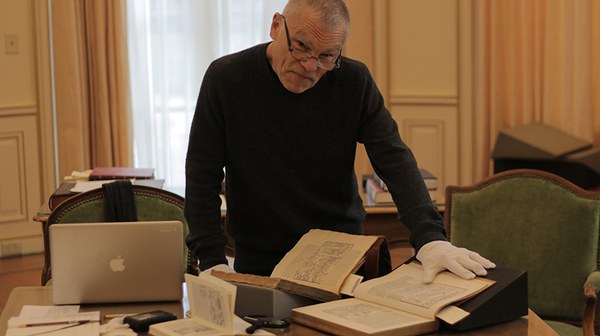For those who already know the Hypnerotomachia Poliphili, the volume needs little introduction; for those who are unaware, the mere title may bewilder. The intimidating Greek neologism means “The Strife of Love in the Dream of Poliphilus,” and it has served for centuries as a kind of password among bibliophiles, especially those dedicated to incunabula, the earliest printed books manufactured before the year 1500.
There are three interrelated characteristics that have made the Hypnerotomachia notorious over the centuries. The first is its visual beauty; the book is one of the Venetian printer Aldus Manutius’s finest works, combining text (set in an instantly legible Roman typeface) with intricate and often enigmatic woodcut illustrations that far surpassed any previously printed book. The second is its language: a disconcerting and highly artificial blend of Italian and Latin with occasional borrowings from other languages, like a Renaissance precursor to the dream language of James Joyce’s Finnegans Wake. The third is its content; on the surface, the Hypnerotomachia appears to be a kind of romance, yet one oddly preoccupied with lengthy descriptions of architecture and ancient rites. It describes the torments and adventures of its protagonist, Poliphilus—shunned by his lover Polia—as he progresses through a bizarre dream world in pursuit of his beloved. Soon after its anonymous publication in 1499, the Hypnerotomachia acquired a reputation for being not just entertainment, but also an elaborate allegory masking knowledge—antique, humanistic, and alchemical—for a learned audience. (In addition to the rivers of ink spilled by entranced scholars over the centuries, the work has even inspired one suspense novel, Ian Caldwell and Dustin Thomason’s The Rule of Four.
The first edition of the Hypnerotomachia apparently failed to sell well, and there are only around thirty copies still extant. But Manutius’s sons printed a second edition in 1545 with the same typesetting and woodcuts. A copy now resides in the Dumbarton Oaks Rare Book Collection. “I’d always wanted a Hypnerotomachia!” explained Librarian Linda Lott. “But I knew a first edition was impossible to get.” In the early 2000s, however, Lott found a copy of the second edition in good shape and without any cuts from censors. (Many copies of the Hypnerotomachia had their most ribald illustrations removed at some point, so a fully intact copy of either of the earliest two editions is precious.) The library acquired it soon after.
Lott then found a second book crucial to understanding the reception and diffusion of the work in Renaissance Europe: an early French translation of the Hypnerotomachia under the title Le tableau des riches inventions couvertes du voile des feintes amoureuses, executed by a polymath by the name of François Béroalde de Verville and published in Paris in 1600. The two books together comprise a powerful pair for making sense of the Hypnerotomachia’s place in the history of ideas. The process of translating the esoteric language of the dream narrative required a dynamic interpretation of what the work means, opening a window onto how the work was being read. In addition, illustrations had to be recut and type had to be reset, the process of which implicated graphic culture in the act of translation and made the translated book potentially as rich an object of study as the original.
Such careful assessment of the course of the Hypnerotomachia’s influence on French culture is a significant part of the research conducted at Dumbarton Oaks this year by 2015–16 Garden and Landscape Studies Fellow Tom Conley, Abbott Lawrence Lowell Professor of Romance Languages and Literatures and of Visual and Environmental Studies at Harvard University. “I’m working on a composite study of space and garden [as] unclassifiable materials right at the cusp of that moment when historians of science like Michel Foucault and François Jacob distinguish between an ‘age of analogy’ and an ‘age of representation,’” Conley explained. “So I’m looking at all of these things right around 1600, when there seems to be a kind of epistemological shift—using materials that aren’t in the established literary canon, but that are nevertheless incredibly rich from a literary point of view and also have a great practical presence.”
Béroalde de Verville worked at this junction to “resuscitate” the work by “bringing gardens and space into an alchemical edition of the Songe de Poliphile,” Conley explained as he pointed to a number of alchemical symbols lurking in an illustration of the translation. “He turns it into something else. . . . The French really crystallizes the Italian, cleans it—and then it turns into more than just a novel, but a book that one consults for the construction of décor de figures in architecture. All those hieroglyphs in the book—they appear on panels, on spiral staircases, on pilasters in Italianized French architecture.” By examining how a text like the Hypnerotomachia expands into fields well beyond “literature” as it is normally construed, Conley hopes to “extend our sense of what social literary space was [like] around 1600.”
Conley consulted Harvard’s other 1499 first edition of the Hypnerotomachia in Houghton Library as well. Houghton also has a second-edition copy (once owned by John Ruskin), several editions of the 1546 French translation edited by Jean Martin, and the 1592 first English edition, translated by Robert Dallington. The Dumbarton Oaks Library also holds a 1998 reproduction of the 1499 edition, and a significant amount of scholarship on the work. Some of the French and English translations have been digitized (and can be viewed online through the HOLLIS catalog), but the two early Manutius editions with the original text are only available for viewing in person. The effort is worthwhile, though; the books are works of art, and the quality of the impression and typesetting, as well as the sophistication of the graphic interplay of image and text, sets this relative newcomer to the collection among the top rank of masterpieces held at Dumbarton Oaks.

